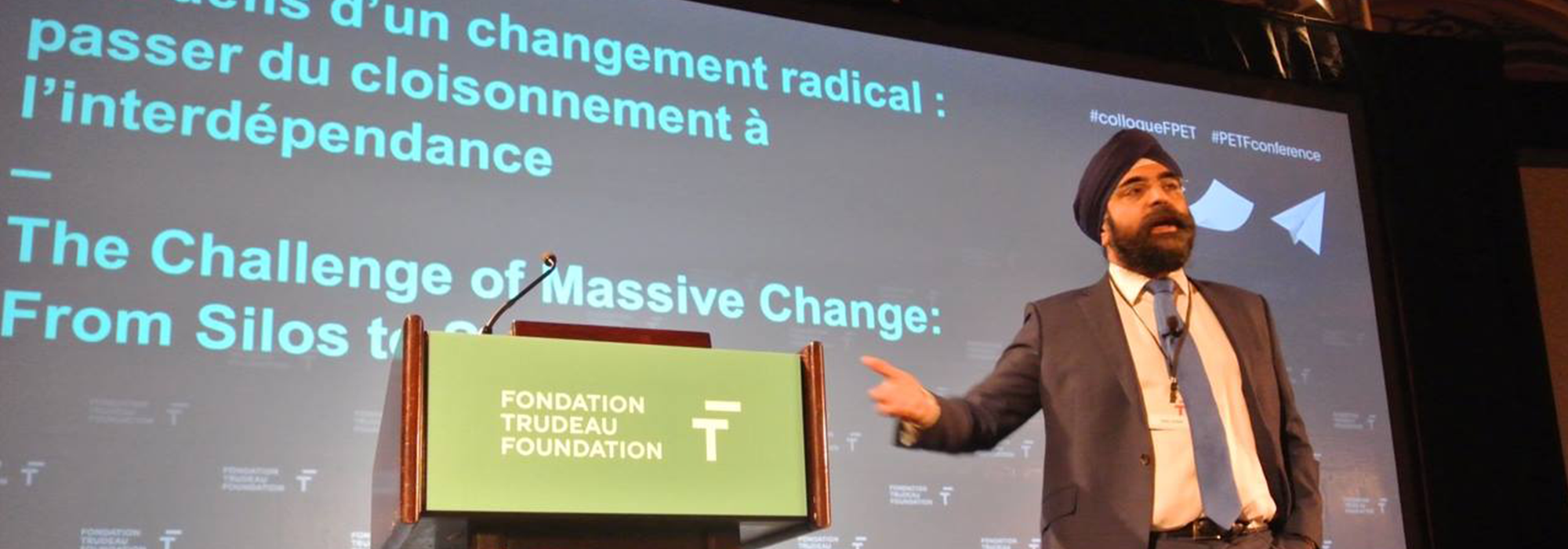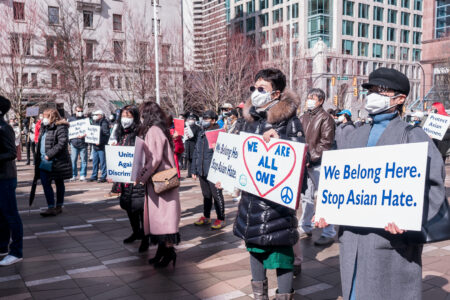
The opening keynote address at the November 2015 conference of the Pierre Elliott Trudeau Foundation was given by Indy Johar, senior innovation associate with the Young Foundation. A mix of big ideas and stories, his talk was titled “The Challenge of Massive Change: From Silos to Systems.”
Disruption drives change. In today’s world of monumental disruption, both formal and informal institutions in all sectors are put to the test: some fail, some adapt, and some transform into a new existence. Change no longer comes from a single actor, organization, institution or domain. Yet, despite increased participation in decision-making and rapid digitally enabled feedback, most large-scale institutions still see society primarily as the site of social, economic or environmental issues rather than as an active participant in generating solutions to these issues. Society is proving them wrong. In a connected, globalized world where human creativity and empathy know ever fewer boundaries, citizen-led movements strike unlikely partnerships, generate solutions or demand action and accountability where corporations and governments tacitly tolerated the status quo.
Johar told a story that began on a busy street in India. On April 5, 2007, Shivam Bajpai turned 16. On his way home from school in the northern city of Kanpur, he was struck down by a car that sped away. Seconds later, as he lay bleeding on the road, another car ran over him. He dragged himself to the curb and lay by a tree, asking for help. Some stopped to stare. Nobody came to help. Nobody called an ambulance. Forty-five minutes later, Bajpai died.
He was one of millions. Every four minutes a person dies in India due to a road accident; the country is the world leader in road fatalities. As a leading cause of death in the 15-to-45 age group, the most productive group of any society, road accidents also have a huge economic cost, with the total cost estimated at 3.2 percent of India’s GDP.
Shivam Bajpai was a cousin of Piyush Tewari. When Tewari found out that an estimated 1,000 people had passed by his dying cousin without stopping, he had to do something. He talked to doctors, police and emergency services. He learned about the need for immediate access to skilled care minutes after an accident, the importance of involving bystanders, and the need to deliver the correct emergency treatment in order to stabilize victims until they can be taken to hospital. He learned that through these actions, 50 percent of accident deaths can be prevented. He learned about the obstacles in the way, including public apathy, the legal repercussions of helping an accident victim (which can turn humane actions into a liability) and the lack of first aid training among police officers.
Much of Tewari’s subsequent work has been about understanding road safety as a system rather than a single issue. He realized that improving road safety was not just a resource, policy, education or behaviour issue; road safety sits at a very uncoordinated and interdependent intersection of fragmented responsibilities, gaps in the legal system and a lack of training. Creating a “chain of survival” would mean connecting citizens, police, ambulances and hospitals. Solutions to this massive challenge required working with all the different moving parts, looking for opportunities to break down silos and creating an environment where the various ministries, departments and stakeholders began to own their parts of the fragmented responsibilities for road safety. Through the SaveLife Foundation that he created, Tewari campaigned for regulatory change (and obtained a ruling from the courts), established a trajectory for culture change to make the police deal more effectively with accidents through training in basic trauma and life support skills, forced toll roads to obtain insurance for accidents and, ultimately, developed a mobile phone app to report incidents. Crucially, the app came last, not first — as the issue is systemic and cannot be solved by shooting a single arrow.
As reported by Sachin Malhan, in the foundation’s first five years, more than 175,000 road accident victims reached medical care with the help of empowered bystanders. Mahlan reflects on Tewari’s work: “These models and lessons learned, which can often look like unscalable ‘products’ when viewed through conventional lenses, are in fact the workable solutions that truly change systems once and for all. Rather than one clear-cut innovation, they represent a combination of innovations in aligning interests, pushing through legal change and creating scalable partnership-led services that can be successfully replicated in other contexts by committed change-makers.”
From the story of the SaveLife Foundation, Johar drew three ingredients for a theory of change for the twenty-first century.
From heroes to movements: The earlier age dominated by the state, the hero and the individual leader led to a convenient set of aspirations about development, investment, accountability and governance. Now, in an interconnected and interdependent world, relations between many actors are characterized less by top-down hierarchies and more by horizontal networks.
As Piyush’s case illustrates, the responsibility for change can no longer be left to any one person or institution. Effective solutions require engagement of the “crowd,” whether it is defined as citizens, entrepreneurs, corporate coalitions or NGOs. Change requires movements that connect multiple actors, creating the capacity to act and innovate across established institutions or grassroots campaigns. The degree to which there are effective interfaces between these diverse actors will be a determining factor of success in creating massive change. Unlocking the potential for postindustrial democratic change in democracies can happen only with a movement of massive multiple stakeholders and the institutional architecture that supports them. This change model requires us to reimagine leadership: to shift from an internal organizational focus to one of building movements around a shared purpose and mission, and putting in place context-specific platforms to get this done. One striking example is the “People for Bernie Sanders” campaign, an independent effort in support of Senator Bernie Sanders’campaign for the Democratic presidential nomination in the 2016. Slogans such as “Together,” “Not me, us” and “Of the people, by the people, for the people” highlight that the campaign is less about Senator Sanders and more about a movement to reclaim US democracy and the economy from corporate interests, despite the tightly shut doors of the establishment donors and media.
From cure to prevention: Though the state at its best has always been inherently an investor in the public good (from property rights to education), the focus was never on what ills such investment resolved but on what greatness it enabled. In contrast, recent austerity drives have all too often cut investment and prevention to the bone, favouring short-term gains over long-term issues and thereby accumulating new costs.
For example, the crisis in accident and emergency care at UK hospitals has been directly related to cuts in community services and care for older people. When older or vulnerable people have nowhere else to turn in the case of minor health scares (often related to mental health problems), they turn exactly to where costs are highest: the emergency room.
An opposite example from Deep River, Ontario, shows how preventive medicine through a community paramedics program caring for seniors living alone has cut the number of 911 calls and ER visits in half. This was achieved through regular home visits by paramedics performing a basic health check and asking seniors how they were doing. The preventive program, costing $75,000 a year, led to a $1.6-million savings by keeping people at home. The logic is compelling: projects that prevent not just the human cost but also the financial cost of various social problems from spiralling out of control enable us to avoid enormous expenditure.
From silos to systems: Massive change needs new models of policy formation, documentation and accountability. It requires reimagination of governance, from its corporate silos to interconnected systems. For much of the past half century, policy makers focused on creating specific policy levers: financial transfers, investments or incentives (sanctions and rewards) so that self-interested, rational individuals would achieve better outcomes. However, today’s deep-seated problems are getting worse as the result of systems failure. As we keep on aiming for a silver-bullet policy-lever approach, we fail to address the interconnected issues across traditional policy silos.
We need to focus on system-scale implementation and innovation to leverage across multiple state and non-state services, actors and investors. Key domains such as innovation, health, education and environment need to be conceptualized as system-wide deliverables, which require coordinated intervention across the numerous leverage points (both direct and indirect) across governmental departments and budgets — but crucially, as Piyush Tewari’s case illustrates, beyond government too.
Arguably, Indy Johar is telling us, the biggest change needed is to shift from the “power of I” to the “power of us.”
Photo: Fondation Trudeau Foundation / Fair Use
Do you have something to say about the article you just read? Be part of the Policy Options discussion, and send in your own submission. Here is a link on how to do it. | Souhaitez-vous réagir à cet article ? Joignez-vous aux débats d’Options politiques et soumettez-nous votre texte en suivant ces directives.







